Cuba + New York = The Music Of Machito and His Afro Cubans – The Padre of Latin Jazz
Cuba has been on my mind recently. Aside from the recent news of protests by the people (Cuba Libre!) and crackdowns by their government, I have also been getting the Cuban experience in my music listening. Cuba has had an influence on jazz far out of proportion to the size of that small island nation. Much of the “latin” music that has entertained fans and inspired musicians over much of the last century has had a Cuban connection. Today we will look at a performer who, while little remembered by mainstream audiences today, was among the most innovative, influential and durable of his genre.
When many think of Cuban music, they think of (or at least used to think of) Desi Arnaz who garnered fame as a singer and bandleader before becoming America’s favorite television husband in I Love Lucy. Older music fans will think of Xavier Cugat who, while not Cuban, at least grew up there before coming to America and leading the most popular latin band of the 1930s. Those bands aimed at mainstream audiences and have a mixed legacy – they brought a taste of Cuban music to the US, but only a taste – in the way that The Olive Garden could be said to have brought a taste of Italian cuisine to America’s heartland in the early 1980s.
But there were other bands that were of, by and for Latino music fans. One of the very best of them was fronted by a Cuban named Francisco Raúl Gutiérrez (Frank) Grillo – best known by his stage name of Machito. Machito’s beginnings are murky – he was born within a year or two either side of 1910 in either Havana or Tampa, but certainly grew up in Havana, raised by the parents of a foster sister named Graciella. He became a musician and played in several groups in Havana starting in the late 1920’s. His professional name was an adjustment to his childhood nickname of “Macho”, bestowed because he was the first boy after three girls. Machito, or little man, seemed to suit his 5’4″ adult stature.
In 1937 his best friend Mario Bauza convinced him to come to New York, where Bauza had been playing trumpet in well-known bands, including those of Chick Webb and Cab Calloway, for the previous six years. With Bauza, Machito started a band in 1940 called Machito and his Afro Cubans that featured Afro-Cuban rhythms within a big band. Bauza was responsible for the sound while Machito (with his big personality) fronted the band as a singer (and shaker of maracas). The band was fairly successful and did some recording, but was a fairly conventional latin band. When Machito was drafted in 1943, Bauza put out a call to Graciella to come to America to front the band in her brother’s absence. Machito was soon back following his discharge from the military after a training injury, and Graciella stayed around for her vocals.
It was also 1943 when Bauza concocted a piece called Tanga, which is widely credited as being the first combination of Afro-Cuban rhythms with American jazz. Over the next few years there was a tremendous cross-pollination between up-and-coming bebop players and Machito’s band, which had become hugely influential among musicians.
Stan Kenton was so excited after hearing them play in 1947 that he recorded a piece called Machito that incorporated much of that band’s Afro-Cuban flavor and made Kenton one of the best known proponents of latin jazz, a style he went back to over and over through the decades. Actually, Kenton even had Machito (and his maracas) join him on a couple of recording sessions , including another hit from 1947, The Peanut Vendor. You can search your favorite music source for those later – today is about the guy who inspired those.
And around that same time Dizzy Gillespie was doing some genuine Afro-Cuban music with a real Afro-Cuban – Chano Pozo. Gillespie had played with Mario Bauza in Chick Webb’s band and it was Bauza who convinced Cab Calloway to hire the hot young trumpet. Bauza is also the guy who made the intro between Gillespie and Pozo. Gillespie never lost his love for real Afro-Cuban sounds. He and Machito made an album together in the 1970’s (one I have not yet had the chance to sample).
Although Machito embedded fairly deeply into American jazz of the late 1940’s, he was not one to follow the crowd. Instead, he really did his own thing, as shown in this 1948 record called Asia Minor. The Machito band never really played so much for the mainstream as for New York’s latino audience that did not have entre’ to the high class venues played by Xavier Cugat or Desi Arnaz. But Machito brought the same top quality musicianship to that audience and set a high musical standard for every latin band to follow.
And the music was never just instrumental. Both Machito and his sister Graciella were frequently in front of the microphone, mostly in spanish. U Bla Ba Du is a great example of how the band’s jazz was folded in with the vocals. I am less of a vocals guy, so the Spanish lyrics don’t bother me at all. For those who like what the vocals bring to Machito’s music, probably half of the band’s output through the years (if not more) featured one or both of that pair in front of the mic. This record, from around 1949, shows how the term CuBop became associated with Machito in the early bebop era.
While American jazz (and especially bebop) after the late 1940’s left dancers behind in favor of ever more sophisticated listeners, Machito never did. Machito knew his audience, and his audience was all about the dancing. So it should be no surprise that he was among the first to popularize the mambo, and could be considered the original Mambo King. New York’s Palladium Ballroom went to an all-latin format in the late 40’s and its three rotating “house bands” were those of Tito Puente, Tito Rodriguez and, of course, Machito (who gave both Puente and Rodriguez their starts in his band). This record of 1951 (or so – it is difficult to date many of Machito’s recordings for small labels) is a great meld of Cuban-latin dance music and jazz. But as the man himself says in the little introduction, “You don’t have to be a Latin. Just relax, and there’s my mambo!”
As the 50’s wore on and musical styles changed, Machito was still Machito, bringing the caliente to the salsa, as in this performance of Sambia from a 1957 album called Mambo Holiday. It is difficult to overstate how big mambo was in the 50’s, and Machito never failed to bring the spices. None other than Count Basie covered Machito’s Mambo Inn in his great 1956 album April in Paris.
But lest you think that Machito had slouched into being “just a Mambo band”, a 1958 all-instrumental album called Kenya showed that Machito still had the chops for Afro-Cuban jazz. That album, by the way, made Robert Dimery’s list of 1001 Albums You Must Hear Before You Die. Having listened to it a few times by now, I heartily agree – there is not a bad track in the bunch. I went back and forth over which track to share here. I finally settled on Tin Tin Deo because it is a mixture of cool and hot done in Machito’s inimitable fashion.
Machito continued as a beloved fixture of latin music into the 1980’s. His last album, Machito and his Salsa Big Band 1982 was still full-on Machito, with the sharp, clear brass and the fat, strong low saxophones atop his always-infectious rhythms. This album, at long last, won him his only Grammy, for Best Latin Album, in 1983. Quimbombo showed the band doing what it had done so well for forty years, but always fresh with both Machito and Graciella still out front on the vocals. Or if you prefer instrumentals, there is an 11 minute rendition of Sambia where soloists have lots of room to keep the party going.
Machito died with his boots on, suffering a massive stroke in 1984 as he prepared to take the stage for a performance in London, at somewhere around 75 years old. Machito’s personal legacy was so much unlike the typical jazz musician we feature here. He was married to the same woman for forty-four years at the time of his death and helped raise five children from their home in New York’s Spanish Harlem. He was a beloved fixture of that city as both a musician and as a man. Even as an old man he volunteered at neighborhood charities for the elderly poor. It seems that Machito loved everybody and everybody loved him back. One son has continued his father’s musical legacy, as did Mario Bauza, until his 1993 death. Graciella was the last of that long-creative trio to go in 2010 at the age of 94. There have been few musical collaborations as durable as the one that featured those three.
There may be no bigger footprint in Afro-Cuban music in particular (or Latin music in general) than that of Machito. His band was almost certainly responsible for more innovations in latin jazz than any other, and was music that virtually every later latino musician absorbed into his pores, knowingly or not. Just listen to Carlos Santana’s Smooth and you can hear Machito’s rhythm. The odd thing is how poorly his music is remembered by most mainstream jazz fans. A definitive discography is hard to come by due to his many recordings with multiple small labels over many decades. Machito generated jazz fans, mambo fans, and latin nostalgia fans, all of whom seem to remember parts of his catalog but never all of it. If I were able to read Spanish, there would be much more online information available.
One last thing – a confession. I have not found a version of that seminal work Tanga before a record from 1949, which was one that featured some then current bebop luminaries like Charlie Parker, Flip Phillips and Howard McGhee. There were actually two recorded at the same session – a 3 minute version for one record side this 5+ minute version that was recorded as Parts 1 and 2. The truth is, while it is a landmark piece, I find it a bit of a challenging listen. I have linked to it, but do not consider it all that representative of the band’s body of work. It is two chords, rhythm and a lot of solos, some of them over one another. It reminds me a little of a party after everyone has gotten good and drunk, and just before the fights start. But while it may not be my favorite maybe you will like it. And next time you listen to the 1962 pop hit Tequila by The Champs, you will know where they got the song’s underpinnings – that’s right, Machito.
So, this tribute went way longer than I intended and has presented a terrible problem of what music to not feature over his 40+ year recording career. Sometimes I will discover a new artist and lose interest after awhile. Other times I will dive in and be drawn deeper and deeper until the music plays on a nonstop loop in my head. By now you can probably guess into which category Machito falls for me. So maybe it’s time to learn how to mambo?
Media credits:
Music as credited on the YouTube pages which have been embedded
Photos 1, 4 and last by William Gottlieb, taken at Glen Island Casino in New York, 1947, and in the public domain.
Record labels and Photo 3 from discogs.com
Photo of Mario Bauza from feflavasalsa.com
1974 photo of Machito, Graciella and Bauza from thecubanbridge.wordpress.com
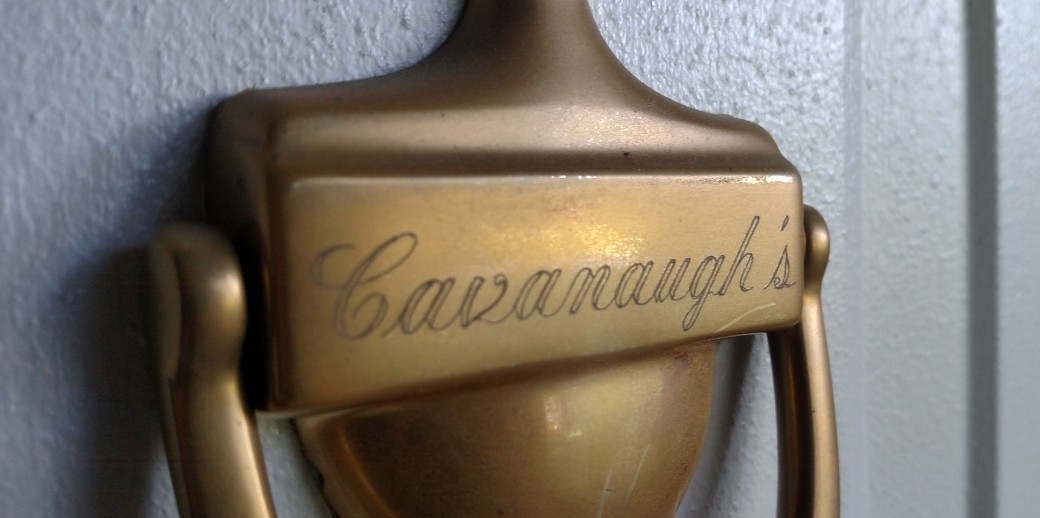


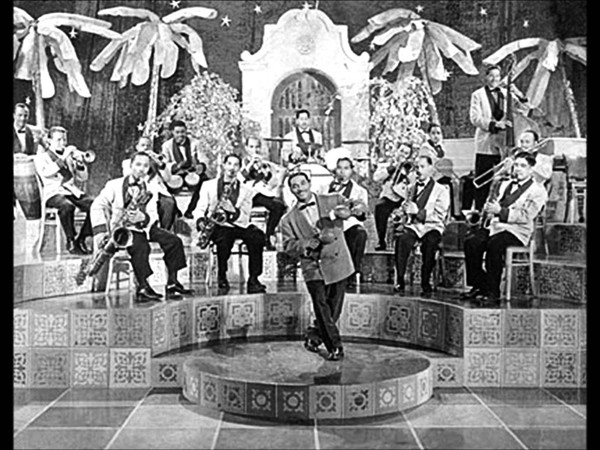
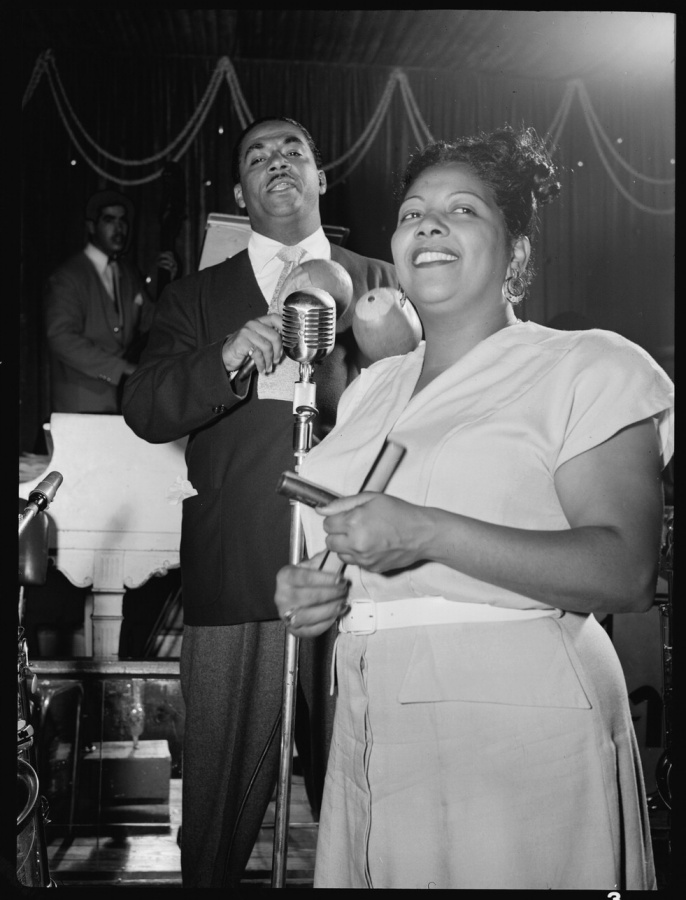



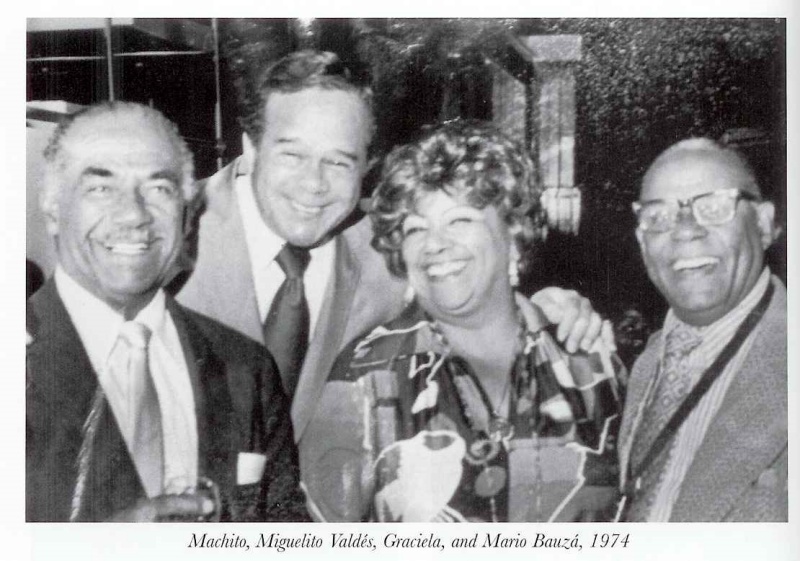

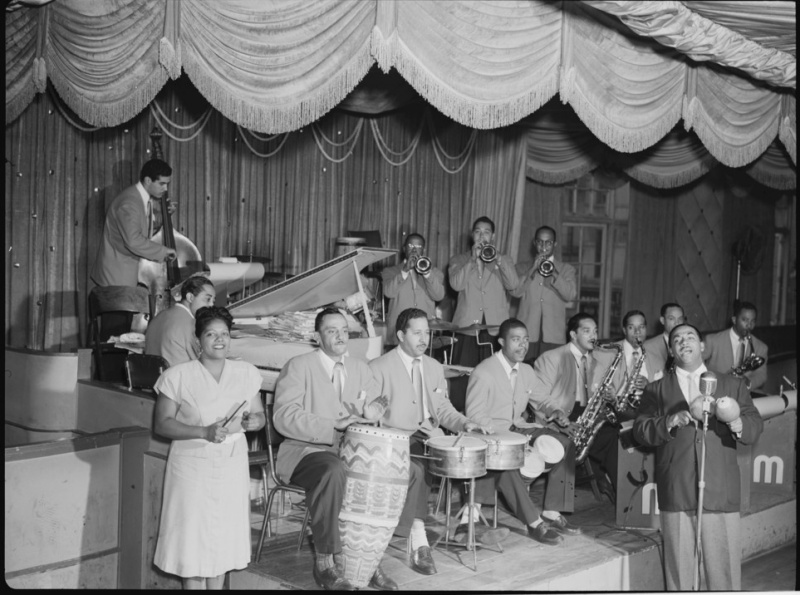
J.P., you’ve done it again! Can’t tell you how much I love Machito and Afro-Cubano jazz! It always seems like a bit of exotica, and the type of blended culture that makes the U.S. what it is and should be! Back when I lived in Chicago in the late 80’s, there used to be a jazz club on the edges of the printers district. Once a week they’d have Latin and Cubano influenced jazz, and I remember to this day, being wowed by the positively ancient aficionados whirling around on the little dance floor! I remember hoping I had it “on fire” that much when I hit that age!
A nod here to Desi as well. Most look at him as a humorous character of 50’s TV, but he did have it going on! I remember going down a rabbit hole after seeing Jim Carrey doing “Cuban Pete” in the movie The Mask; and finding a Youtube version with Desi that shows every bit of smooth talent he had (at least before Lucy steps in and turns the number into a farce), not to mention Desi’s one of the few guys besides August Darnell (Kid Creole) that looks great in a straw boater!
LikeLiked by 1 person
I can’t believe how long it took me before I got into this trove of goodness. In the research I did I came across a video done in a New York Park in probably the late 70s, and here is this old gray-haired guy singing in front of the kind of big band that had not been in style among we anglos for 30 years, and there was this crowd of people, young, old and in between just lapping it up and dancing up a storm, clearly having a blast. Machito seemed to be a unifying force everywhere he went and in everything he did. His band, in fact, is credited as the first racially integrated outfit from its formation in 1940. Where bands in the US were stuck dealing with some ugly legacies on race, the black and white Cubans did their thing together and everyone was cool with it.
I remember doing a mini-dive into Desi’s band stuff – he was actually a pretty big deal from maybe 1945-47, and was even the band for one of the big-name national radio shows (it may have been Bob Hope) for awhile. Apparently several of the Afro-Cuban musicians didn’t think a lot of Desi – the consensus was that he was pretty good on his drums, but that he watered-down the music for popular appeal. As was his way, Machito would have none of that, giving Desi full props for making the music popular and bringing attention to other guys like him.
LikeLike
Interesting, I hadn’t heard of CuBop and yeah I think the whole Lucy thing didn’t help.
Also I saw what you did with Kenton there 😉
LikeLiked by 1 person
Yeah, I specifically thought of you when I decided to not put the Kenton link in. 🙂 But that was the segue that got me to this.
LikeLike
That Lucy and Desi video was a hoot! I had totally forgotten about him, and the Tequila song….famous for conga lines in Mexican resorts in my youth….and now it’s stuck in my head!
LikeLiked by 1 person
Conga lines? Mexican resorts? It sounds like you have some stories to blog about. 🙂
I remember being a little disappointed when Lucy would turn Desi’s musical performances into comedy bits – but of course that was the only reason they were there in the first place, of course.
LikeLiked by 1 person
Just to be clear JP I myself never participated in the conga lines, but at one particular resort towards the end of the night the Tequila song would come on and all the drunk people would! I know Lucy was very popular, but I always found her kind of silly, and annoying in some way.
LikeLiked by 1 person
J.P., I had to laugh when I read that comment. I, too, even as a youngster, remember being disappointed every time Lucy broke up the band at the club. I always wanted to hear more of the band and Desi!
LikeLiked by 1 person
It’s a good thing you posted that Desi & Lucy clip, or else you and I may have been the only comments this week. 🙂
The 78Prof has posted Desi’s 1946 record of Cuban Pete. Play it and you can see how much of Machito Desi’s band had picked up by the time of the version on I Love Lucy.
LikeLike
Wow! This version is almost like the “easy listening” version! By the time of the show, Desi and the band got a little “hotter” and faster!
LikeLiked by 1 person
I remember Desi singing at “the club” in the old “I Love Lucy” programs – that takes me back … longer than I’d care to admit. 🙂
LikeLiked by 1 person
That show was in perpetual reruns for years. I always wanted to hear more of the theme song.
LikeLiked by 1 person
I probably saw the reruns and not the original shows. I’ve had an ear worm ever since that video. 🙂
LikeLiked by 1 person
Here’s a fresh one, from my latest Down Beat Magazine: Arturo O’Farrill and the Afro Latin Jazz Orchestra: Virtual Birdland…four stars!
LikeLiked by 1 person
Pingback: The Making of Ella Fitzgerald | J. P.'s Blog